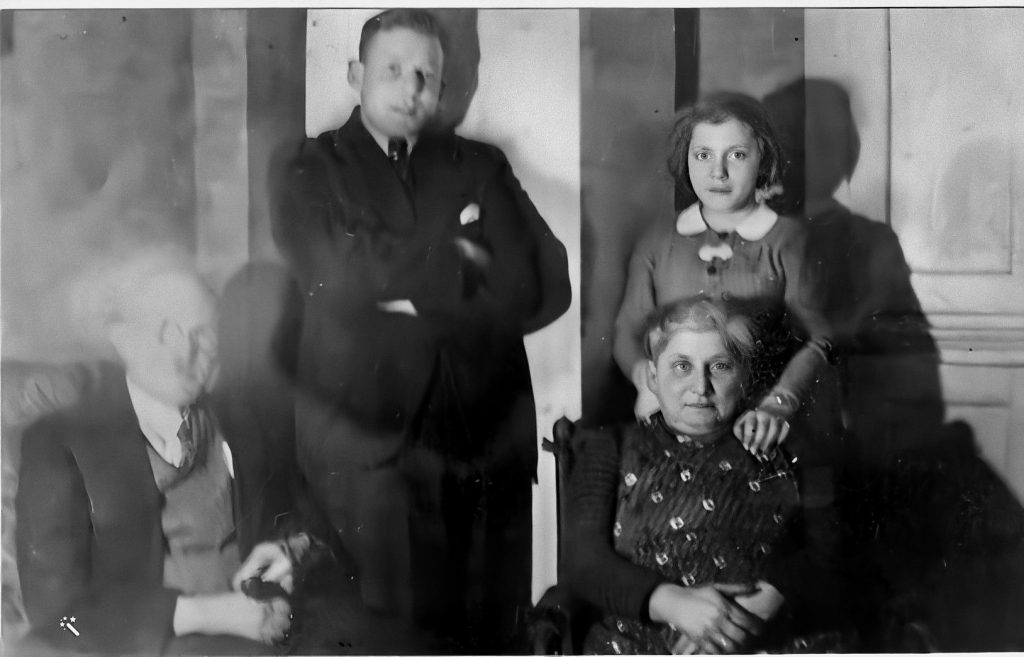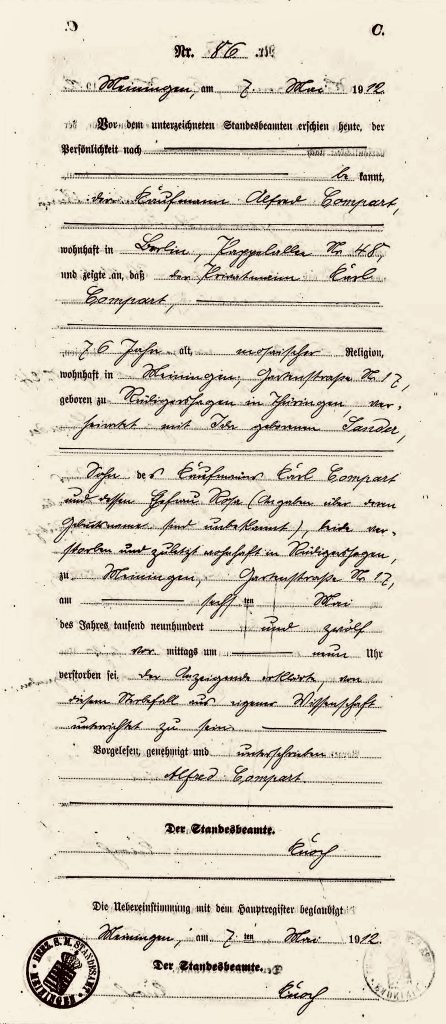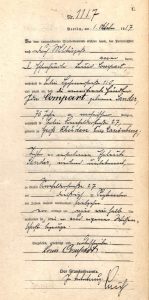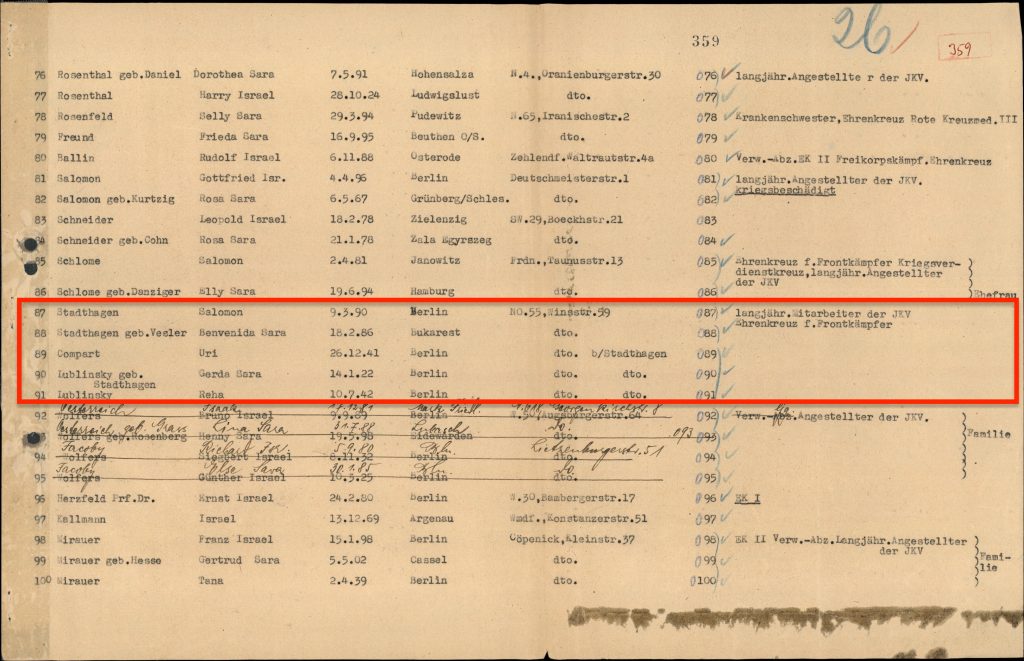
Note to reader: This page is under construction. Thank you for your patience.
See Descendants List: Carl and Ida (née Sander) Compart
The photo above is in the Yad Vashem photo Hall of Names archives identified as “Photograph of Compart, Alfred,” b. 1881, resident in Berlin. No further identification of the individuals is included nor the context as to how the photo came to Yad Vashem. Luckily, a relative of the family also had a copy of the photo and was able to tell us who was who.

Alfred Compart was born in 1881 in Themar, son of Karl and Ida (née Sander) Compart.
Carl Compart was born in 1837 in Rüdigershauen in Thuringia, and Ida Sander was born 1842 in Gross Rhüden, in Lower Saxony, the daughter of Alexander and Röschen (née Liebmann) Sander. They married in 1865 and settled in the town of Schleusingen in Thuringia, where they had six children: Louis, b. 1866; Hulda, b. 1868; Anna, b. 1871; Jenny, b. 1873; Lena, b. 1875; and Selma, b. 1877. Two of these children died: Lena, born died in 1885, and Hulda as a 5-year-old.
Karl and Ida moved to Themar with four children in the late 1870s: Selma Sophie, b. January 1877, was the last child born in Schleusingen. On 15 February 1879, a girl was born in Themar. Initially, the name “Friederike” was recorded in the Jewish Registry but later this name was struck through and replaced with “Röschen.” Alfred was born on 19 October 1881, the last child of Karl and Ida (née Sander) Compart.
The Compart family left few traces of their stay in Themar. We do not know where the Comparts lived in Themar. We do know that they left Themar but not exactly when. The entry in the Jewish Register of Themar recorded the 1885 death of Röschen. It also notes that Carl and Ida moved from Themar to Meiningen. Since the enty does not note the departure of Jenny for the United States in 1886, it’s possible that the family moved to Meiningen before Jenny left.
By the first decade of the 1900s, four of Carl and Ida’s children were living in Berlin. Three married in ceremonies in Berlin: on 15 January 1909, Selma Sophie married a cousin, Louis Compart; on 8 September 1910, Alfred married Fanny Rothmann; and 0n 2 May 1912, Louis married Olga Rohr.
 Carl and Ida Compart remained in Thuringia, living in Meiningen. Carl died on 5 May 1912 in Meiningen; it was Alfred who registered his death with the Meiningen City Registrar. Ida then moved to Berlin with her daughter Anna, who was blind. Ida died in 1917, after which Anna continued to live with one or other of her siblings.
Carl and Ida Compart remained in Thuringia, living in Meiningen. Carl died on 5 May 1912 in Meiningen; it was Alfred who registered his death with the Meiningen City Registrar. Ida then moved to Berlin with her daughter Anna, who was blind. Ida died in 1917, after which Anna continued to live with one or other of her siblings.

By the end of World War I, the Compart siblings in Berlin — Louis, Selma Sophie, and Alfred — had formed families. In 1910, Selma Sophie gave birth to a daughter, Lieselotte. Louis and Olga had two children: Fritz, b. 1914, and Ellen, b. 1920. Alfred and Fanny lost their first born in 1911; in May 1914, Kurt was born. A third child, named Paul Heinz, lived but a year, June 1918 to June 1919. A daughter, Paula Ida, was born in 1924.
There are no records to indicate that Jennie in the United States had any children: in 1898, she married Edward Liebmann in Tacoma, Washington. It appears that Liebmann died; that is, he and Jennie did not divorce as Jennie is identified as a widow in the certificate for her second marriage in 1921. Her second husband was a relative, Louis Compart, b. 1866 in Rüdigershagen, who had come to the United States in June 1880. He lived in San Francisco and had become an American citizen in 1905.
*****
When the Nazi regime began on 30 January 1933, 14 members of the Carl and Ida Compart family were living in Germany, all in Berlin. In May 1933, Lieselotte, daughter of Sophie and Louis Compart, left Berlin for Amsterdam with her husband Nathan Norbert Stiebel. Like many other German Jews, they hoped that Holland would remain neutral were war to break out. Nathan registered as a merchant and Lieselotte as a fur worker. In 1934, a son, Werner, was born, and four years later, a daughter, Ruth Ida.
The families of Louis and Olga, Sophie and Louis, and Alfred and Fanny, remained in Berlin. At present, we have no records that indicate that they reached out to their sister Jennie in San Francisco for assistance to leave Germany.
What do we know about their lives during the 1930s? Very little: we have but one photo that shows us the four members of Alfred and Fanny’s family in 1935. Alfred was 54 years old, Fanny 52. On 15 January 1938, Louis Compart, husband of Selma Sophie died, the last death before the organized round-ups and imprisonments of German Jews in concentration camps began.
In 1938, when German Jews with secular given names needed to add “Israel” or “Sara” to their names, Alfred Compart wrote a long letter to the City Registrar of Themar. Include.
*****
The first deportation from Berlin occurred on 18 October 1941, when 1013 Jews were transported to the Litzmannstadt Ghetto. It did not include any of the Comparts. The first murder of a family member occurred in May 1942, when Alfred Compart was arrested on 27 May 1942 by the Gestapo in Berlin and taken to Sachsenhausen concentration camp with 153 other men to be shot. The men were murdered there the next day.
Willi Creutzenberg, who has researched this execution, provides detail about Alfred’s fate and that of his immediate family: Alfred’s daughter Paula gave the following account of her father’s arrest and murder as a witness at the Auschwitz trial in 1964:
“For this courageous act (referring to the attack on the exhibition ‘The Soviet Paradise’, author’s note), the head of the Baum group, 26 men and one woman, were executed. It was claimed at the time that five of them had set the fire, and for each of them 250 other resistance fighters and friends of the Soviet Union were taken away. My father was among these 250. For fourteen days we had no idea where my father was. Then one day my mother received a letter saying that they wanted to inform her of the death of her husband and that he had died in May, on May 29, along with the other 250.”
Just three weeks after Alfred Compart’s murder, the remaining family members, his wife Fanny, son Kurt and daughter Paula, were deported from Berlin to Theresienstadt on 19 June 1942 on the 8th transport of the elderly. A few weeks later, on 21 September 1942, his brother-in-law Louis Compart and his wife Olga were also deported from Berlin to the Theresienstadt Ghetto. On 26 October 1942, Louis and Olga’s son Fritz and his wife Ruth chose to end their own lives rather than be deported on that day. They left their year-old boy Uri in the care of Ruth’s parents, Salomon and Benevida Stadthagen, and Ruth’s sister, Gerda, who also had an infant child, Reha, b. July 1942.
Louis Compart died in Theresienstadt Ghetto on 10 May 1943. On 17 May 1943, his grandson Uri was deported to Theresienstadt with his maternal Stadthagen grandparents, his aunt Gerda, and his younger cousin Reha.

For the next year, Louis’s widow Olga and her grandson Uri, the four Stadthagens, and Alfred’s widow Fanny and their two children were in the Theresientadt Ghetto. Starting in May 1944 and 06 October 1944, the group of Compart family members and relatives were transported to Auschwitz as follows: On 16 May 1944, Olga Compart left Theresienstadt; on 29 September 1944, Salomon Stadthagen left. On 4 October 1944, Fanny Compart and her two children, Kurt and Paula, were also deported from Theresienstadt to Auschwitz. On 6 October 1944, Uri Compart, now 3 years old, left with his grandmother Benvenida Stadthagen, and his aunt Gerda and cousin Reha.
Paula Compart described the selection at the ramp after their arrival in Auschwitz-Birkenau by SS-Obersturmführer Karl-Friedrich Höcker as follows:
“When we had to get off the trains, we held on to each other. Yes, and the SS were standing all over the camp road, and they only made one hand movement, to the right and left. And that meant either death or going to the camp itself. My mother was told to go to the other side and I clung to her and shouted that I wanted to stay with my mother. Then an SS officer tore me from her side, hit me with his fist and kicked me with his foot – several [+ blows], not just one. And I was told afterwards by an SS officer who was standing right next to me, who also hit me: “You’ll go there too.”
The further fate of the mother and brother is documented by a few documents. While the mother was gassed in Auschwitz, Kurt – presumably as a participant in one of the death marches in connection with the evacuation of the Auschwitz camp – was sent to Dachau. There he was registered as a prisoner of the Dachau concentration camp on January 27, 1945. Four weeks later, on February 3, 1945, he died there, presumably as a result of the extreme stress of the death march.
Paula Compart herself remained in the Birkenau camp for only a short time. Together with 500 Jewish women from Germany, the Czech Republic, Slovakia, Hungary and the Netherlands, she was transferred from the Auschwitz II Birkenau concentration camp to the Freiberg subcamp of the Flossenbürg concentration camp in October 1944. She was registered in this camp on October 12, 1944 and given the prison number 53974, where she was forced to work in an armaments factory during the last months of the war. With a lot of luck, she survived all the hardships and was liberated at Flossenbürg concentration camp at the end of the war.